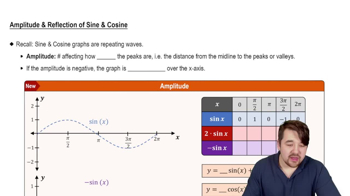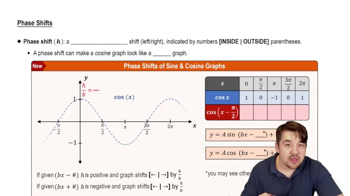Table of contents
- 0. Review of College Algebra4h 43m
- 1. Measuring Angles39m
- 2. Trigonometric Functions on Right Triangles2h 5m
- 3. Unit Circle1h 19m
- 4. Graphing Trigonometric Functions1h 19m
- 5. Inverse Trigonometric Functions and Basic Trigonometric Equations1h 41m
- 6. Trigonometric Identities and More Equations2h 34m
- 7. Non-Right Triangles1h 38m
- 8. Vectors2h 25m
- 9. Polar Equations2h 5m
- 10. Parametric Equations1h 6m
- 11. Graphing Complex Numbers1h 7m
4. Graphing Trigonometric Functions
Graphs of Tangent and Cotangent Functions
Problem 4.13c
Textbook Question
For each function, give the amplitude, period, vertical translation, and phase shift, as applicable.
y = (1/2)csc (2x - π/4)
 Verified step by step guidance
Verified step by step guidance1
Identify the amplitude: For the cosecant function, amplitude is not typically defined as it is for sine and cosine. However, the coefficient in front of the csc function, \( \frac{1}{2} \), affects the vertical stretch or compression.
Determine the period: The period of the cosecant function is determined by the coefficient of \( x \) inside the function. The formula for the period of \( csc(bx) \) is \( \frac{2\pi}{b} \). Here, \( b = 2 \), so the period is \( \frac{2\pi}{2} = \pi \).
Find the phase shift: The phase shift is determined by the horizontal translation inside the function. The formula is \( \frac{-c}{b} \) where \( c \) is the constant added or subtracted from \( x \). Here, \( c = -\frac{\pi}{4} \) and \( b = 2 \), so the phase shift is \( \frac{-(-\frac{\pi}{4})}{2} = \frac{\pi}{8} \).
Identify the vertical translation: There is no constant added or subtracted outside the function, so the vertical translation is 0.
Summarize the transformations: The function \( y = \frac{1}{2}csc(2x - \frac{\pi}{4}) \) has a vertical stretch by a factor of \( \frac{1}{2} \), a period of \( \pi \), a phase shift of \( \frac{\pi}{8} \) to the right, and no vertical translation.
Recommended similar problem, with video answer:
 Verified Solution
Verified SolutionThis video solution was recommended by our tutors as helpful for the problem above
Video duration:
0m:0sPlay a video:
Was this helpful?
Key Concepts
Here are the essential concepts you must grasp in order to answer the question correctly.
Amplitude
Amplitude refers to the maximum distance a wave reaches from its central axis. In the context of trigonometric functions, it is typically associated with sine and cosine functions. However, for cosecant functions, which are the reciprocal of sine, the amplitude is not defined in the same way, as cosecant can take on values from negative to positive infinity.
Recommended video:

Amplitude and Reflection of Sine and Cosine
Period
The period of a trigonometric function is the length of one complete cycle of the wave. For the cosecant function, the period can be determined from the coefficient of x in the argument of the function. In this case, the period is calculated as 2π divided by the coefficient of x, which is 2, resulting in a period of π.
Recommended video:

Period of Sine and Cosine Functions
Phase Shift
Phase shift refers to the horizontal shift of a trigonometric function along the x-axis. It is determined by the constant added or subtracted from the x variable in the function's argument. For the function y = (1/2)csc(2x - π/4), the phase shift can be found by setting the inside of the function equal to zero, leading to a shift of π/8 to the right.
Recommended video:

Phase Shifts

 5:43m
5:43mWatch next
Master Introduction to Tangent Graph with a bite sized video explanation from Nick Kaneko
Start learningRelated Videos
Related Practice














